As someone who has always been ambivalent about art fairs and their circus-like distractions, whose barkers -- like so many whores dressed in fine clothing -- would have us think that money isn't their sole objective, I'm nevertheless intrigued by all the off-shoots to the major players. And so with New York's Armory Show now upon us, I decided to talk to Ed Winkleman, who along with his partner, Murat Orozobekov (both of Winkleman Gallery), have created one of the latest and more promising of these off-shoots, "Moving Image, the Contemporary Video Art Fair." Organized to provide a better viewing experience for visitors, collectors especially, Moving Image presents single-channel and installation-based video by a variety of international artists in an environment designed to encourage immersive engagement with time-based work that might otherwise be skipped over. As a capitulation to the increasingly truncated attention spans of fair goers, and a more just approach allowing video artists a proper context for the reception of their work, one could say its very 21st century. Winkleman, ever the principled pragmatist, shares why.
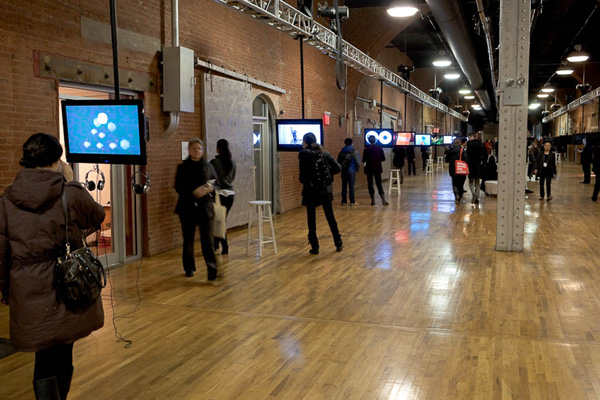
Moving Image, New York installation, 2011
JH: How has the impetus to create a better format suited to the economic needs of dealers and the unique nature of the video medium alike shaped the structure of the fair, conceptually and practically? And have the two concerns/interests of both groups always been in accord?
EW: There are two main factors driving the format of Moving Image. First is the recognition that in your average art fair, with their fast-paced tempos, many visitors will fly past videos (even many art world insiders have admitted this to me) because of the tight schedules they're on and the simple fact that videos are more time-consuming than most other media. In Moving Image we have worked to create a context in which it's easier to slow down and yet still retain the energy of a fair. Second is the fact that the art fair business has become international, but the technology behind much of the moving-image based artwork has not yet. Moving Image is designed to eliminate much of the risk and expense of sending equipment overseas, just to find it doesn't work there, by including the equipment and set-up in the participation fee for the single-channel video works. This permits the participating galleries to literally (just send the disc or video files) and focus their time and efforts on more important things, like meeting clients or attending other events in the fair city.
JH: When you say "we have worked to create a context in which it's easier to slow down and yet still retain the energy of a fair", how exactly is this accomplished in your estimation? And how would you say this context differs from earlier attempts to create viewer-friendly video experiences at fairs?
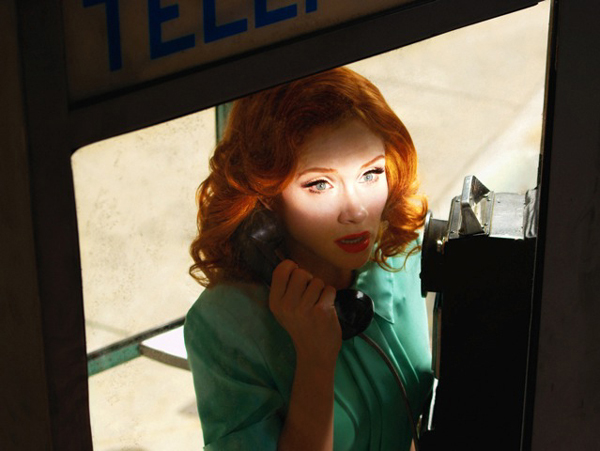
Alex Prager, Despair, 2010, Yancey Richardson Gallery (New York, N.Y.)
EW: As much as we're conscious of the risk of "ghettoizing" video (which is why Moving Image remains committed to both experimentation in presentation AND collaboration with existing art fair models... as evidenced by two such collaborations this year... one with The Armory Show, for which Moving Image is organizing the program for Armory Film, and Gallerist, which is partnering with Moving Image to present the fair online), we are also conscious of the need to carve out a space in which visitors know they'll find moving-image-based work there. We also avoid the darkened rooms that most people think of when they think "video installation" to ensure a lively environment, as open as possible, in which dialog is encouraged.
We recognize, however, that not all moving-image-based work is best viewed in that environment. Sometimes the "cinema" experience is called for, which again, is why Moving Image is delighted to collaborate with The Armory Show on the inaugural Armory Film.
Overall, though, our goal is to ensure moving-image-based work, which is growing in terms of contemporary art practice, has a stronger presence at the major fairs, because that's where so much of the sales are happening these days.
Hunter Reynolds, Mummification Heart Transformation, 2012, P.P.O.W Gallery (New York, N.Y.)
JH: This year's fair includes contributions by Valie Export, Ken Jacobs, Hunter Reynolds, Kate Gilmore, Zang Peili, and Miguel Angel Rojas, among others -- a diverse lineup that to presumably involves selection protocols that begin with cost but also involve aesthetic and curatorial considerations, among othersl. Indeed, this year you appointed curator Janet Phelps as director. How and why did you decide to go this route?
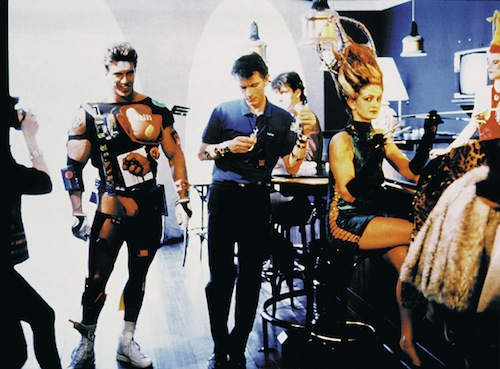
Valie Export, Perfect Couple or Indecency Sheds Its Skin, 1986, Charim Gallery (Vienna, Austria)
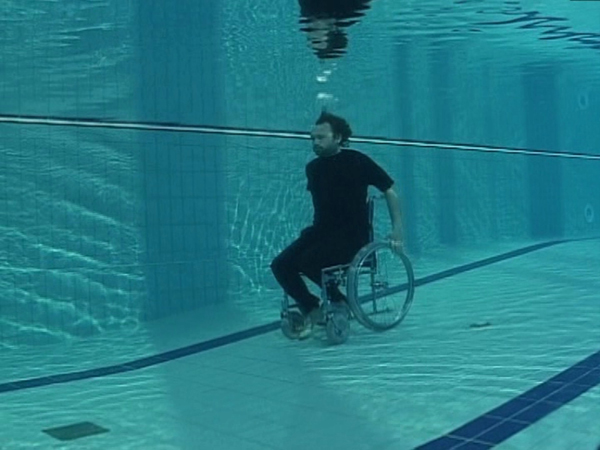
Jaan Toomik, Seagulls, 2004, Temnikova and Kasela Gallery (Tallinn, Estonia)
EW: The selection of artists involves an outreach by our Curatorial Advisory Committee and a discussion with the Moving Image Team, with the overall objective being to present a wide spectrum of artworks (including sculpture and other multimedia works to underscore that video is not only being used for monitor or screen based presentations), as well as an interesting historical mix: i.e., some of the artists participating are legendary and others are just getting started. This diversity is entirely intentional.
JH: Can you give more insight into this process such as who was chosen to be on the committee, and why, and how it functions in tandem with Phelps and your own agenda as a gallerist featuring his artists in the fair? I'm specifically interested in knowing how much is business driven and how much purely curatorial, and/or how the two were brought together.
EW: Moving Image is a commercial art fair, so it's business driven in the respect that we are VERY interested in building a larger, stronger market for video art. Our belief, however, is that it is "art" and, as with any other medium, the best way to increase the number of collectors who wish to support it is to present a high-quality presentation in a context considered specifically for that art.
JH: So is there an application process?

Jesse Fleming, The Snail and the Razor, 2012, The Company (Los Angeles, Calif.)
EW: There is no application process for Moving Image. The exhibitors are all invited. We ask each person from Curatorial Advisory Committee to nominate 15-20 artists and galleries to participate. As for the criteria by which they're invited, it runs the gamut from, "we really want artist X in the fair this time, s/he's doing some amazing new work" to concerns as mundane as "we need more artists from [this or that] region of the world... we're too [region] heavy." We limit each participating gallery to a max of two artists, with a total of up to 30 galleries, but most important is to keep the mix international.
Not every gallery that is invited can participate, though, so we do have a few rounds of invitations. Also, because the work presented is time-based, we keep the total number of artists/galleries small compared to your average fair. We don't want to exhaust the visitors with too much work, and this helps make the invitation process relatively quick as well.
JH: How do you think your fair improves upon what came before, and are there specific precedents that inspired you?
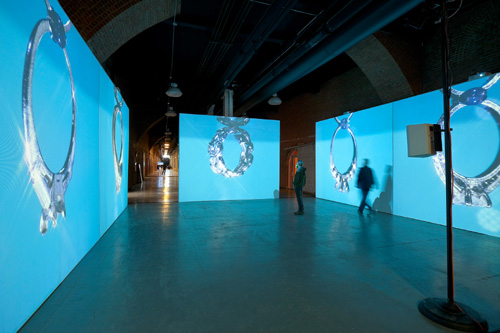
Moving Image, New York installation, 2011
EW: There is one particular precedent that had a big impact on us. The "California Video" exhibition at the Getty in 2008 included a large number of video works, but they were installed in a fresh and very inviting way. We left that exhibition feeling that the darkened rooms approach to showing video at some fairs could be improved upon, with some of the ideas the Getty had used, such as modular stations for monitor-based single-channel works, and as few walls as possible for installations, leaving the viewer more connected to other visitors and less isolated. Of course, certain works require a more cinematic presentation, and we're very pleased to have been invited to organized the Armory Film series at the Armory Show, where we've selected 20 contemporary films that are being screened in a theater/media lounge.
JH: That's fantastic news. In a review of last year's inaugural fair, one participant expressed concern that the structure could interfere with sales. "It might lead to fewer possibilities," said Zuzanna Janin of Local 30 gallery in Warsaw. "A collector could walk by and like something, but then see something else and keep going, and I wouldn't know." Suggesting the fair install armchairs for the dealers on the floor next year, she added, "I think it's more of an experiment... but I still have to cover my costs." Has this issue been taken into consideration this year?
Predator Prey from Janet Biggs on Vimeo. Janet Biggs, Predator Prey, 2011-12, Winkleman Gallery (New York, N.Y.)
EW: We have taken that feedback (as well as a lot of other feedback we've received) into consideration. There is no question Moving Image is experimental in its approach to presentation. We remain committed to seeing how much we can signal to the viewer that they should take their time. Having a dealer hovering over you, however, doesn't send that message as strongly as room to move around unhindered. As art dealers ourselves, we are nonetheless clearly interested in sales, and so keep fine tuning how Moving Image connects the collector with the artist's gallery. We have very detailed wall text, for example, with full contact information, and even QR Codes for immediate self-serve information. There are information desks with full details on each work, including prices, available upon request. Dealers are welcome to be anywhere they like at the fair throughout the entire event as well, plus we have a specific Gallerist Lounge where they can work in between conversations if they like.
